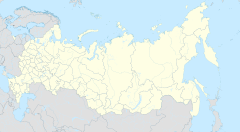User:Jack Sebastian/Serpantinka
| Serpantinka | |
|---|---|
| concentration camp, extermination camp | |
| Coordinates | 62°31′16″N 149°37′06″E / 62.52111°N 149.61833°E |
| Other names | Gulag |
| Location | Kolyma Russian Far East |
| Built by | Stalin |
| Operated by | USSR |
| Commandant | Colonel Stepan Nikolaivich Garanin |
| Original use | political prison |
| Inmates | Counterrevolutionaries, Mensheviks, Trotskyists, Socialist-Revolutionaries |
| Number of inmates | Unknown |
| Killed | over 10,000 |
| Liberated by | closure |
The Serpantinka ( Russian: Serpantinkin) was a Soviet extermination camp[1] located in the heart of the Kolyma region and part of a system of Gulags itself run by the Dalstroy, also known as Far North Construction Trust,[2], set up in 1931 by the Soviet NKVD (the predecessor of the KGB) in order to manage road construction and the mining of gold in the Magadan-Chukotka region of the Russian Far East, now known as Kolyma. It was administered by the GPU, later by the NKVD and in the final years by the Ministry of Internal Affairs (MVD).
General Overview
[edit]Serpantinka was the most significant mass execution site of Kolyma[1], with almost all executions occurring between the autumn of 1937 and November 1938 during the Great Terror period. All death row inmates of the region were brought to Serpantinka to "clean the camps of their most hardened criminal elements and counterrevolutionary" influences [1]. A special death camp was created in Serpantinka for the purpose of prisoner extermination.[3].[4]
History
[edit]Built in the 1930s and consists of three buildings. One of them was reserved for management and guards, and the whole prison was surrounded by a high wooden fence with a courtyard where prisoners were executed.[1]
Establishment
[edit]Forced labor
[edit]Executions
[edit]Because precise records were never kept at the Serpantinka, an accurate accounting of the dead may never be known. However, Stalin expected a quota of 12,000 executions 2 in the Russian Far East, where Kolyma was the essential region of deportations.
"It can be estimated that there are between six and ten thousand prisoners executed here (20,700 in Butovo between 1937 and 1938, 10,000 in Bykivnia, 9,500 in Sandarmokh)."[citation needed]
An average of several dozen prisoners were executed per day during the years 1937 and 1938. The bodies were buried in large trenches, but unlike at other camps, it was not the detainees who dug the mass graves. The NKVD staff did so (despite several hurdles, such as digging in the permafrost) because they did not want the prisoners to understand that it would be their sentence.
Camp Layout
[edit]Travel to Serpantinka requires travel through the Kolyma, a region of Russia where temperatures plummet well below freezing much of the year. From the small abandoned mining town of Khatynnakh, travelers take a winding path that leads to a deep gorge where there is never sun since it is surrounded by hills1. It is from this winding path path that the camp takes its name.[1]
Commandants
[edit]Memorial
[edit]A memorial stonge was erected and dedicated to the victims of Serpantinka on 22 June 1996.[4]
In media
[edit]The people who were exported to the Serpantinka were considered to be counterrevolutionary , Socialist-Revolutionary , Trotskyist or Mensheviks and were accused of violations of the settlement of other Kolyma camps, attempted escape, refusal to work, collective protests , hunger strikes, suicide attempts or self-mutilation 1 . These accusations allowed the authorities present in the region of Kolyma, the NKVD, to justify the deportation of individuals in order to respect the quotas set by Stalin 2. The accused had no means of defense against their sentence and had no information about the fate that awaited them, namely the death penalty 1 .
Testimony of a survivor "This court was hardly different from those rural slaughterhouses found in most Russian villages. The convicts, shackled, were shot in the back of the neck. The court was stained with blood that stagnated for days [...]. The guards came for the convicts with small batches of half a dozen or so. It was known when the executions took place at the noise of the engines of two tractors that the killers were snoring to cover the sound of the detonations of the Nagan 4 pistols . "
References
[edit]- ^ a b c d e Werth, Nicolas (2016). La route de la Kolyma : Voyage sur les traces du goulag (The Kolyma Road: A Journey in the Footsteps of the Gulag). Paris, France: Belin. ISBN 9782701198019.
- ^ Russian: Гла́вное управле́ние строи́тельства Да́льнего Се́вера; acronym: ГУСДС.
- ^ Bollinger, Martin J (2003). Stalin's Slave Ships: Kolyma, the Gulag Fleet, and the Role of the West. Santa Barbara, Cal: Praeger Publishing (Greenwood). p. 16. ISBN 978-0-275-98100-6. Retrieved 11 September 2019.
{{cite book}}: More than one of|pages=and|page=specified (help) - ^ a b Alstrup, Jens. "Kolyma: The white crematorium". Gulag.eu. Retrieved 10 September 2019.

